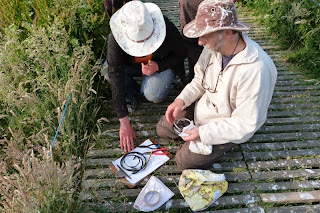 |
| Star Tern...our first ever Bridled Tern this summer |
 |
| A long over-due first ever Red Kite |
.JPG) |
| Spring Black-headed Bunting |
 |
| Our 11th Yellow-breasted Bunting |
 |
| Stunning winter addition; Bonaparte's Gull |
 |
| One of two Citrine Wagtails |
 |
| An impressive nine Great Spotted Woodpeckers |
 |
| Southern delight; Hoopoe this autumn |
.JPG) |
| A good year for Balearic Shearwaters |
Saturday 9th November comments: It’s been an impressive year for the Farne Islands as we’ve had some great weather, the seabirds have done well, lots of visitors have enjoyed the seabird spectacular and the media coverage has been outstanding. To add to the many fine achievements, we added a new one today; a record number of bird species seen in a year.
The record for the number of birds recorded in a season stood at 189 (set in 2005) but today with a group of six Scaup recorded flying north, we have broken this record and now sit proudly on 190 species. And its not over as although migration is grinding to a standstill we still have time to add a few more before we leave.
This year has seen some impressive visitors including three ‘first’ for the islands; the stunning Bridled Tern, a long over-due Red Kite and Pectoral Sandpiper. Just as rare came Bonaparte’s Gull, White-rumped Sandpiper and Black Kite for the second time whilst other major highlights have included our 4th and 5th Citrine Wagtail, 6th Black-headed Bunting and 11th Yellow-breasted Bunting.
Not bad for 80 acres of rock sticking out in the north sea….
Highlights this year:
1st Bridled Tern, Pectoral Sandpiper and Red Kite
2nd Black Kite, White-rumped Sandpiper, Bonaparte’s Gull
4th -5th Citrine Wagtail
5th-6th Little Egret
6th Black-headed Bunting
6th-7th Fea’s Petrel
8th Olive-backed Pipit
10th Nightjar, Hoopoe, Marsh Warbler
11th Yellow-breasted Bunting
11th-13th Greenish Warbler
Other noticeable highlights: Balearic Shearwater (minimum of four), Leach’s Petrel, Spoonbill. Marsh Harrier, Osprey,
Corncrake, Wood Sandpiper (two), Iceland Gull, Glaucous Gull, Cuckoo (two), Great Spotted Woodpecker (nine northern race birds),
Red-backed Shrike (two), Hooded Crow (two), Firecrest, Shorelark,
Pallas’s Warbler, Yellow-browed Warbler (twenty), Wood Warbler,
Barred Warbler,
Icterine Warbler (three),
Bluethroat (two),
Red-breasted Flycatcher (three),
Richard’s Pipit, Mealy Redpoll (invasion), Common Crossbill and
Common Rosefinch (two).







+1.JPG)
.jpg)
.jpg)
+4.JPG)



































.JPG)





.JPG)